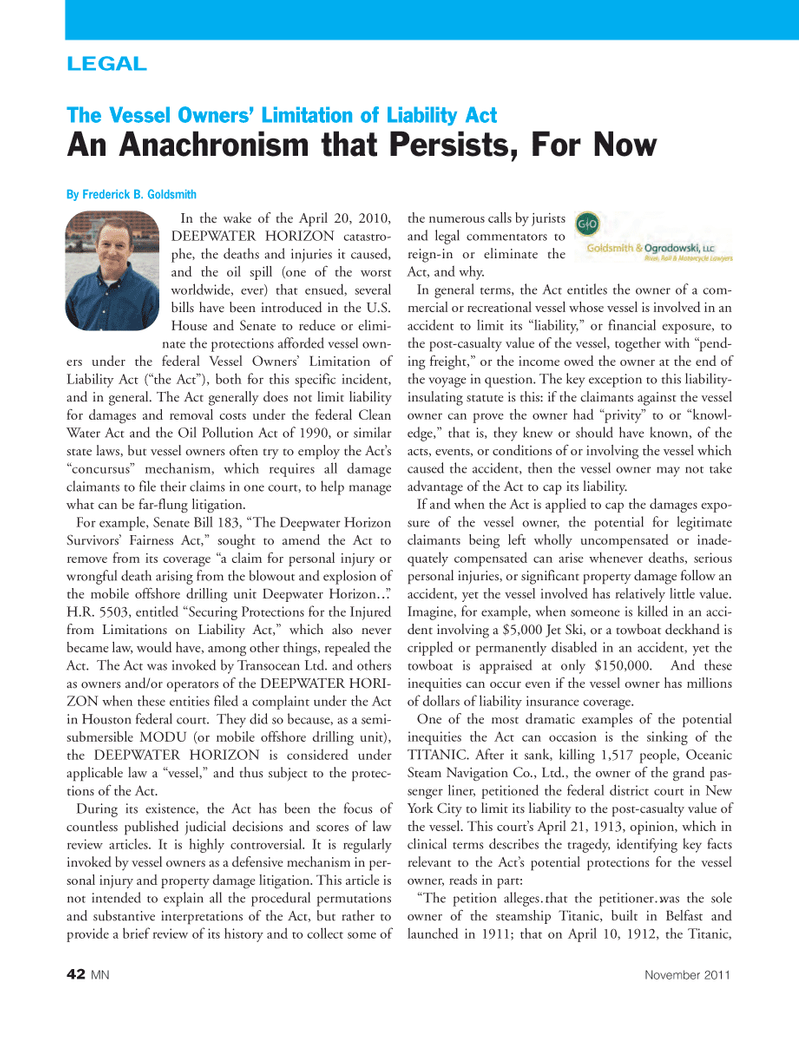
Page 42: of Marine News Magazine (November 2011)
Workboat Annual
Read this page in Pdf, Flash or Html5 edition of November 2011 Marine News Magazine
42MNNovember 2011LEGALIn the wake of the April 20, 2010, DEEPWATER HORIZON catastro- phe, the deaths and injuries it caused,and the oil spill (one of the worstworldwide, ever) that ensued, several bills have been introduced in the U.S. House and Senate to reduce or elimi- nate the protections afforded vessel own- ers under the federal Vessel Owners? Limitation of Liability Act (?the Act?), both for this specific incident, and in general. The Act generally does not limit liability for damages and removal costs under the federal Clean Water Act and the Oil Pollution Act of 1990, or similar state laws, but vessel owners often try to employ the Act?s ?concursus? mechanism, which requires all damage claimants to file their claims in one court, to help manage what can be far-flung litigation.For example, Senate Bill 183, ?The Deepwater Horizon Survivors? Fairness Act,? sought to amend the Act to remove from its coverage ?a claim for personal injury or wrongful death arising from the blowout and explosion of the mobile offshore drilling unit Deepwater Horizon? .?H.R. 5503, entitled ?Securing Protections for the Injured from Limitations on Liability Act,? which also never became law, would have, among other things, repealed the Act. The Act was invoked by Transocean Ltd. and others as owners and/or operators of the DEEPWATER HORI- ZON when these entities filed a complaint under the Act in Houston federal court. They did so because, as a semi- submersible MODU (or mobile offshore drilling unit), the DEEPWATER HORIZON is considered under applicable law a ?vessel,? and thus subject to the protec- tions of the Act. During its existence, the Act has been the focus of countless published judicial decisions and scores of law review articles. It is highly controversial. It is regularly invoked by vessel owners as a defensive mechanism in per- sonal injury and property damage litigation. This article is not intended to explain all the procedural permutations and substantive interpretations of the Act, but rather to provide a brief review of its history and to collect some of the numerous calls by jurists and legal commentators toreign-in or eliminate the Act, and why. In general terms, the Act entitles the owner of a com- mercial or recreational vessel whose vessel is involved in an accident to limit its ?liability,? or financial exposure, to the post-casualty value of the vessel, together with ?pend- ing freight,? or the income owed the owner at the end of the voyage in question. The key exception to this liability- insulating statute is this: if the claimants against the vessel owner can prove the owner had ?privity? to or ?knowl- edge,? that is, they knew or should have known, of the acts, events, or conditions of or involving the vessel which caused the accident, then the vessel owner may not take advantage of the Act to cap its liability. If and when the Act is applied to cap the damages expo- sure of the vessel owner, the potential for legitimate claimants being left wholly uncompensated or inade-quately compensated can arise whenever deaths, serious personal injuries, or significant property damage follow an accident, yet the vessel involved has relatively little value. Imagine, for example, when someone is killed in an acci- dent involving a $5,000 Jet Ski, or a towboat deckhand is crippled or permanently disabled in an accident, yet the towboat is appraised at only $150,000. And these inequities can occur even if the vessel owner has millions of dollars of liability insurance coverage. One of the most dramatic examples of the potential inequities the Act can occasion is the sinking of the TITANIC. After it sank, killing 1,517 people, Oceanic Steam Navigation Co., Ltd., the owner of the grand pas- senger liner, petitioned the federal district court in New York City to limit its liability to the post-casualty value of the vessel. This court?s April 21, 1913, opinion, which in clinical terms describes the tragedy, identifying key facts relevant to the Act?s potential protections for the vessel owner, reads in part: ?The petition alleges?that the petitioner?was the sole owner of the steamship Titanic, built in Belfast and launched in 1911; that on April 10, 1912, the Titanic, By Frederick B. Goldsmith The Vessel Owners? Limitation of Liability Act An Anachronism that Persists, For Now MN#11 (32-49):MN 2011 Layouts 10/27/2011 9:56 AM Page 42

 41
41

 43
43
